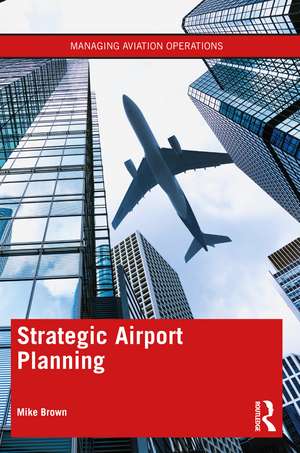Strategic Airport Planning: Managing Aviation Operations
Autor Mike Brownen Limba Engleză Paperback – 11 apr 2022
The book explains the importance of articulating a clear strategy, based on a rigorous analysis of the competitive landscape while avoiding the pitfalls of ambiguity and ‘virtue signalling’. Having done so, demand forecasts can be developed that resemble S-curves, not simple straight lines, that reflect strategic opportunities and threats from which a master plan can be developed to allocate land and capital in a way that maximizes return on assets and social licence. The second distinctive feature of this book is the premise that planning an airport as an island, a fortress even, does not work anymore given how interconnected airports are with other components of the transportation system, the economies and communities they serve and the rapid pace of social and technological change. In summary, the book argues that airport planning needs to move beyond its traditional boundaries.
The book is replete with real examples from airports of all sizes around the world and includes practical advice and tools for executives and managers. It is recommended reading for individuals working in the airport business or the broader air transport industry, members of airports’ board of directors, who may be new to the business, elected officials, policy makers and urban planners in jurisdictions hosting or adjacent to airports, regulators, economic development professionals and, finally, students.
Preț: 294.38 lei
Nou
Puncte Express: 442
Preț estimativ în valută:
56.33€ • 58.97$ • 46.61£
56.33€ • 58.97$ • 46.61£
Carte disponibilă
Livrare economică 17-31 martie
Livrare express 28 februarie-06 martie pentru 25.55 lei
Preluare comenzi: 021 569.72.76
Specificații
ISBN-13: 9781032002354
ISBN-10: 1032002352
Pagini: 184
Ilustrații: 9 Tables, black and white; 75 Line drawings, black and white; 1 Halftones, black and white; 76 Illustrations, black and white
Dimensiuni: 156 x 234 x 11 mm
Greutate: 0.27 kg
Ediția:1
Editura: Taylor & Francis
Colecția Routledge
Seria Managing Aviation Operations
Locul publicării:Oxford, United Kingdom
ISBN-10: 1032002352
Pagini: 184
Ilustrații: 9 Tables, black and white; 75 Line drawings, black and white; 1 Halftones, black and white; 76 Illustrations, black and white
Dimensiuni: 156 x 234 x 11 mm
Greutate: 0.27 kg
Ediția:1
Editura: Taylor & Francis
Colecția Routledge
Seria Managing Aviation Operations
Locul publicării:Oxford, United Kingdom
Public țintă
Adult education, Postgraduate, Professional, and Professional ReferenceCuprins
Chapter 1: Why Plan?
Chapter 2: Strategic Planning
Chapter 3: Demand Forecasting
Chapter 4: Master Planning For Passengers
Chapter 5: Master Planning For Cargo
Chapter 6: Airport Area Planning
Chapter 7: Economic Impact
Chapter 8: Looking Ahead
Chapter 9: Summary and Conclusions
Chapter 2: Strategic Planning
Chapter 3: Demand Forecasting
Chapter 4: Master Planning For Passengers
Chapter 5: Master Planning For Cargo
Chapter 6: Airport Area Planning
Chapter 7: Economic Impact
Chapter 8: Looking Ahead
Chapter 9: Summary and Conclusions
Notă biografică
Mike Brown has 35 years of experience in the airport industry and has completed strategic plans, master plans and economic impact assessments at Canada’s two largest airports, Toronto Pearson and Vancouver International, amongst others, and has a track record of innovation, analytical rigour and successful execution. Mike is currently Honorary Senior Research Fellow in the Transport Strategy Centre at Imperial College, London, where he works with nine global hub airports on improving business performance.
Recenzii
'Mike Brown’s book provides a perceptive insight into the complexity of developing airports across the world.'
Peter A Forbes, BA FRAeS FCLIT, AEROSPACE magazine (January 2024), UK
Peter A Forbes, BA FRAeS FCLIT, AEROSPACE magazine (January 2024), UK
Descriere
The aim of the book is to articulate a new approach to airport planning that better captures the complexities and velocity of change in our contemporary world. As a result, it will lead to higher performing airports for users, business partners, investors and other stakeholders.








